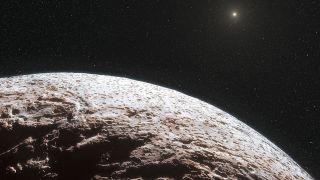
An artist’s impression of Makemake.
(Image credit: ESO/L. Calçada/Nick Risinger (skysurvey.org))
Two dwarf planets within our solar system, named Eris and Makemake, might exhibit enough geothermal activity to maintain oceans of liquid water within, according to modeling that describes new observations made with the James Webb Space Telescope.
“We see some interesting signs of hot times in cool places,” said Christopher Glein, a planetary geochemist from Texas’ Southwest Research Institute, in a statement.
Found deep in the Kuiper Belt, Eris is the icy world that, when it was discovered in January 2005, threw Pluto’s status in the solar system into crisis. Just 44 kilometers (27 miles) smaller than Pluto but 25% more massive thanks to a greater concentration of rock in its core, Eris became the prototype dwarf planet. Pluto was inevitably forced to follow suit. Makemake (pronounced “Mah-kay-Mah-kay”) was spotted two months after Eris, and at 1430 km (888 miles) across is about 1000 km (about 600 miles) smaller than Eris and Pluto.
Related: Dwarf Planet Makemake: An Icy Wonder in Pictures
Their great distance from the Sun —– Eris is currently 14.4 billion kilometers (8.9 billion miles) away and Makemake is 7.7 billion kilometers (4.8 billion miles) away – means little is known about these faraway dwarf planets.
However, recent observations with the James Webb Space Telescope have shed new light on the worlds, finding a surprising origin for the frozen methane-ice on their surface.
“We found evidence pointing to thermal processes producing methane from within Eris and Makemake,” said Glein.
Methane is what’s known as a hydrocarbon, in that it is formed from a mixture of hydrogen and carbon atoms (specifically, one carbon atom and four hydrogen atoms.) Those atoms can come in different flavors, or “isotopes,” containing the same number of protons but different numbers of neutrons.
If the methane on these dwarf planets’ surfaces had been accreted from the primordial planet-forming disk that existed around the young sun 4.5 billion years ago, they would contain a certain isotopic ratio between two isotopes of hydrogen — regular hydrogen, with one proton and zero neutrons, and deuterium, with one proton and one neutron. The hydrogen isotope ratio measured by the JWST, however, is different to the ratio that would be expected if the methane were primordial, as we see on most comets.
“The deuterium/hydrogen ratio points to geochemical origins for methane produced in the deep interior,” said Glein. “Our data suggest elevated temperatures in the rocky cores of these worlds so that methane can be cooked up. Molecular nitrogen could be produced as well, and we see it on Eris.”
In other words, hydrothermal reactions, or metamorphic activity which refers to heat and pressure acting on rocks, must have produced the methane deep inside Eris and Makemake. Then, that methane must’ve made its way to the surface via outgassing, or even volcanism.
For methane to form in this manner, a temperature in excess of 150 degrees Celsius (about 300 degrees Fahrenheit) is required. These temperatures could only come from radioactive isotopes present within the rocky cores of each dwarf planet giving off heat as the isotopes decay.
“Hot cores could also point to potential sources of liquid water beneath their icy surface,” said Glein, raising the possibility that Eris and Makemake could contain possibly habitable oceans.
The outgassing of methane onto the surface may have been happening until (geologically) recently according to another isotope ratio, between carbon-12, which has 6 protons and 6 neutrons, and carbon-13, which has 6 protons and 7 neutrons.)
“If Eris and Makemake hosted, or perhaps could still host warm, or even hot, geochemistry in their rocky cores, cryovolcanic processes could then deliver methane to the surfaces of these planets, perhaps in geologically recent times,” said Will Grundy of Lowell Observatory, who led the initial JWST observations. “We found a carbon isotope ratio that suggests relatively recent resurfacing.”
Intriguingly, the models developed to describe the formation and outgassing of methane on Eris and Makemake could also apply to Saturn’s moon Titan. Research published earlier this month indicated that methane and other carbon-based molecules important for life might not be able to reach Titan’s subsurface ocean after hanging out on the surface for a bit,e where hydrocarbons are plentiful. This called into question the presumed possible habitability of Titan’s ocean. However, if methane and other gases can form geothermally within the rocky core of Titan, as they do on Eris and Makemake, then Titan’s ocean could get its supply of carbon chemistry from within the planet rather than from its surface.
The results of the methane observations on Eris and Makemake are described in a paper published in the April 2024 issue of the journal Icarus.
Join our Space Forums to keep talking space on the latest missions, night sky and more! And if you have a news tip, correction or comment, let us know at: community@space.com.
Breaking space news, the latest updates on rocket launches, skywatching events and more!
Keith Cooper is a freelance science journalist and editor in the United Kingdom, and has a degree in physics and astrophysics from the University of Manchester. He’s the author of “The Contact Paradox: Challenging Our Assumptions in the Search for Extraterrestrial Intelligence” (Bloomsbury Sigma, 2020) and has written articles on astronomy, space, physics and astrobiology for a multitude of magazines and websites.
>>> Read full article>>>
Copyright for syndicated content belongs to the linked Source : Space.com – https://www.space.com/dwarf-planets-solar-system-eris-makemake-water-methane
